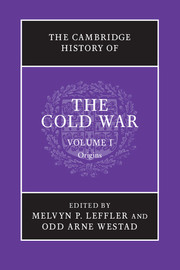Book contents
- Frontmatter
- 1 The Cold War and the international history of the twentieth century
- 2 Ideology and the origins of the Cold War, 1917–1962
- 3 The world economy and the Cold War in the middle of the twentieth century
- 4 The emergence of an American grand strategy, 1945–1952
- 5 The Soviet Union and the world, 1944–1953
- 6 Britain and the Cold War, 1945–1955
- 7 The division of Germany, 1945–1949
- 8 The Marshall Plan and the creation of the West
- 9 The Sovietization of Eastern Europe, 1944–1953
- 10 The Cold War in the Balkans, 1945–1956
- 11 The birth of the People’s Republic of China and the road to the Korean War
- 12 Japan, the United States, and the Cold War, 1945–1960
- 13 The Korean War
- 14 US national security policy from Eisenhower to Kennedy
- 15 Soviet foreign policy, 1953–1962
- 16 East Central Europe, 1953–1956
- 17 The Sino-Soviet alliance and the Cold War in Asia, 1954–1962
- 18 Nuclear weapons and the escalation of the Cold War, 1945–1962
- 19 Culture and the Cold War in Europe
- 20 Cold War mobilization and domestic politics: the United States
- 21 Cold War mobilisation and domestic politics: the Soviet Union
- 22 Decolonization, the global South, and the Cold War, 1919–1962
- 23 Oil, resources, and the Cold War, 1945–1962
- Bibliographical essay
- Index
- References
14 - US national security policy from Eisenhower to Kennedy
Published online by Cambridge University Press: 28 September 2010
- Frontmatter
- 1 The Cold War and the international history of the twentieth century
- 2 Ideology and the origins of the Cold War, 1917–1962
- 3 The world economy and the Cold War in the middle of the twentieth century
- 4 The emergence of an American grand strategy, 1945–1952
- 5 The Soviet Union and the world, 1944–1953
- 6 Britain and the Cold War, 1945–1955
- 7 The division of Germany, 1945–1949
- 8 The Marshall Plan and the creation of the West
- 9 The Sovietization of Eastern Europe, 1944–1953
- 10 The Cold War in the Balkans, 1945–1956
- 11 The birth of the People’s Republic of China and the road to the Korean War
- 12 Japan, the United States, and the Cold War, 1945–1960
- 13 The Korean War
- 14 US national security policy from Eisenhower to Kennedy
- 15 Soviet foreign policy, 1953–1962
- 16 East Central Europe, 1953–1956
- 17 The Sino-Soviet alliance and the Cold War in Asia, 1954–1962
- 18 Nuclear weapons and the escalation of the Cold War, 1945–1962
- 19 Culture and the Cold War in Europe
- 20 Cold War mobilization and domestic politics: the United States
- 21 Cold War mobilisation and domestic politics: the Soviet Union
- 22 Decolonization, the global South, and the Cold War, 1919–1962
- 23 Oil, resources, and the Cold War, 1945–1962
- Bibliographical essay
- Index
- References
Summary
US grand strategy during the presidencies of Dwight D. Eisenhower and John F. Kennedy derived, in the broadest sense, from the same, deep-seated fear: that the Soviet Union’s combination of implacable hostility, mounting military strength, and positive ideological appeal posed a fundamental — even existential — threat to US national security. The emergence of an equally hostile China as a military power in its own right deepened the perception they shared of an unusually menacing external environment. Eisenhower and Kennedy each accepted the basic goals of the containment strategy developed during the Harry S. Truman presidency, to be sure. But differing assessments about the precise nature and extent of the Communist threat, coupled with divergent judgments about how best to check it and what resources were available for the task, generated quite distinct tactical approaches to national security policy during the Eisenhower and Kennedy administrations.
Long before he assumed the presidency, Dwight D. Eisenhower had been giving serious and sustained thought to questions of strategy. As a West Point cadet, he had imbibed the fundamental precepts of Carl von Clausewitz’s classic nineteenth-century treatise on warfare. Later, of course, he gained invaluable practical experience in the formulation and implementation of strategic plans as the Supreme Commander of Allied Forces in Europe during World War II. One of Eisenhower’s deepest core beliefs held that national security encompassed much more than the physical defense of the homeland; it meant to him, in the broadest sense, protecting the nation’s basic values, its economic system, and its domestic institutions. In that respect, Eisenhower was formly convinced that the greatest threat to national security emanated less from the potential for military defeat than from excessive government spending; striking an appropriate balance between the cost of an adequate defense and the need to maintain a healthy, solvent economy constituted, accordingly, a crucial aspect of strategy.
- Type
- Chapter
- Information
- The Cambridge History of the Cold War , pp. 288 - 311Publisher: Cambridge University PressPrint publication year: 2010
References
- 7
- Cited by

